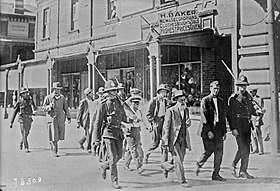The Rand Rebellion (Afrikaans: Rand-rebellie; also known as the 1922 strike) was an armed uprising of white miners in the Witwatersrand region of South Africa, in March 1922. Jimmy Green, a prominent politician in the Labour Party, was one of the leaders of the strike.
| Rand Rebellion | |||||||
|---|---|---|---|---|---|---|---|
| Part of the Revolutions of 1917–1923 | |||||||
 Rebels being taken prisoner in Fordsburg | |||||||
| |||||||
| Belligerents | |||||||
|
|
| ||||||
| Commanders and leaders | |||||||
|
|
| ||||||
| Casualties and losses | |||||||
|
~200 killed[1] 4 executed | |||||||
Following a drop in the world price of gold from 130 shillings (£6 10s) per fine troy ounce in 1919 to 95s/oz (£4 15s) in December 1921, the companies tried to cut their operating costs by decreasing wages, and by weakening the colour bar by promoting cheaper black mine workers to skilled and supervisory positions.[2]
History
editThe rebellion started as a strike by white mine workers on 28 December 1921 and shortly thereafter, it became an open rebellion against the state.[3]: 292 Subsequently the workers, who had armed themselves, took over the cities of Benoni and Brakpan, and the Johannesburg suburbs of Fordsburg and Jeppe.
The young Communist Party of South Africa (CPSA) took an active part in the uprising on grounds of class struggle whilst reportedly opposing racist aspects of the strike,[4] as did the syndicalists. The racist aspect was typified by the slogan; "Workers of the world, unite and fight for a white South Africa!" and by several organised attacks against blacks.[5]
Several Communists and syndicalists, the latter including the strike leaders Percy Fisher and Harry Spendiff, were killed as the rebellion was quelled by the Union Defence Force.[6] The rebellion was eventually put down by "considerable military firepower and at the cost of over 200 lives".[7]
Prime Minister Jan Smuts crushed the rebellion with 20,000 troops, artillery, tanks, and bomber aircraft. By this time the rebels had dug trenches across Fordsburg Square and the air force tried to bomb but missed and hit a local church. However, the army's bombardment finally overcame them.[8] Lieutenant Colonel Llewellyn Andersson's role in creating the Union Defence Force was instrumental in crushing the rebellion.[9]
Smuts' actions caused a political backlash, and in the 1924 elections his South African Party lost to a coalition of the National Party and Labour Party.[3]: 292 They introduced the Industrial Conciliation Act 1924, Wage Act 1925 and Mines and Works Amendment Act 1926, which recognised white trade unions and reinforced the colour bar.[10] Under instruction from the Comintern, the CPSA reversed its attitude toward the white working class and adopted a new 'Native Republic' policy.[11][12]
After the strike, 18 strikers were sentenced to death for murder, of which 14 were reprieved. The four men to not be reprieved, were Carel Christian Stassen, Taffy Long, Herbert Hull, and David Lewis, were all executed by hanging at Pretoria Central Prison. Stassen was hanged on October 5, 1922, while the other three men were hanged together on November 17, 1922. He was convicted of killing two black men, John Setsuta and John McKenzie, in what witnesses said were racially motivated killings. Long was convicted of killing a police informant, while Hull and Lewis were convicted of killing a soldier. As they marched to the gallows, Long began singing the "Red Flag", the anthem of early socialists and communists in South Africa. He was joined in the song by the other two men. As they walked, all the prisoners sang with them.[13][14]
In popular culture
editA TV series in 8 episodes produced by the SABC in 1984 and entitled 1922, tells this part of South African history.[15]
In Agatha Christie's The Man in the Brown Suit, published in 1924, the Rand Rebellion is mentioned both by name and as a backdrop for the mystery. Christie washes over the specifics and uses the Rebellion as nothing more than a minor inconvenience for her characters.
In Wilbur Smith's A Sparrow Falls one of the principle characters becomes embroiled with some of the organisers of the Rand Rebellion in Fordsburg and fictionalised descriptions of some of the first skirmishes with the authorities are described.
Bibliography
edit- Jeremy Krikler, Rand Revolt: The 1922 Insurrection and Racial Killings in South Africa, Jonathan Ball Publishers SA, 2006, ISBN 978-186842-189-3
- Wessel Pretorius Visser, A History of the South African Mine Workers' Union, 1902-2014, Edwin Mellen Press, 2016, ISBN 978-1-4955-0460-0
See also
editReferences
edit- ^ Bendix, S. (2001). Industrial relations in South Africa. Claremont: Juta. p. 59. ISBN 978-0-7021-5279-5.
- ^ "Fifty fighting years – chapter 3". sacp.org.za.
- ^ a b Joyce, Peter (1989). The South African family encyclopaedia. Cape Town: Struik Publishers. ISBN 978-0-86977-887-6.
- ^ Baruch Hirson, The General Strike of 1922
- ^ "South Africa Conflict in the 1920s - Flags, Maps, Economy, Geography, Climate, Natural Resources, Current Issues, International Agreements, Population, Social Statistics, Political System". workmall.com.
- ^ V.I. Lenin. "Lenin: 703. TO G. Y. ZINOVIEV". marxists.org.
- ^ Butler, A. 2004. Contemporary South Africa. Hampshire and New York: Palgrave Macmillan
- ^ "Battle of Fordsburg Square". blueplaques.co.za. Retrieved 20 June 2013.
- ^ "Lady Milner". The Times. London. 24 January 1939. p. 14.
- ^ Conflict in the 1920s, accessed June 2013
- ^ Roux, E. R. (28 July 1928). "Thesis on South Africa, presented at the Sixth Comintern Congress". sahistory.org.za.
- ^ Bunting, S. P. (23 July 1928). "Statement presented at the Sixth Comintern Congress". sahistory.org.za.
- ^ "Carel Stassen | True Crime Library". 20 October 2015. Retrieved 23 October 2023.
- ^ Says, Person (17 November 2013). "ExecutedToday.com » 1922: Taffy Long, Herbert Hull, and David Lewis, Rand rebels". Retrieved 23 October 2023.
- ^ 1922 (Drama), Michael McGovern, Jonathan Rands, Pamela Perry, Independent Film Centre, 10 May 1984, retrieved 6 September 2023
{{citation}}: CS1 maint: others (link)